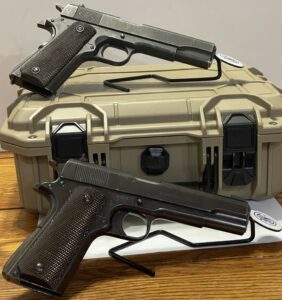…here’s another gun that was featured in a “Preview of coming attractions” post a while back.
Since I’ve written a lot about the 1911 in the past, and plan to write a lot about 1911s in the future, I can make this a somewhat shorter than usual for gun crankery post.
(Also, I think at this point I need a “1911” sub-category under “Guns”. I think a “Smith and Wesson” category was long overdue as well.)
Mike and I were out at Provident Arms in Spicewood a while back, just making the rounds and poking around.
The guy behind the counter (GBtC) said, “Hey, do you want to see something cool?”

“Hey, do you want to see something cool?” is, to my mind, one of the most dangerous phrases you can hear in a gun shop. Especially if, like me, you have Smith and Wesson tastes and a Jennings budget.
Anyway, we indicated our assent, and GBtC pulled this out.


It’s not a 1911A1. It’s a real honest to God Colt 1911.

Yes, it has the four line Colt patent and the US property mark.

And the Model of 1911 stamp on the side, along with the RIA marking.
I realize the differences between the 1911 and the 1911A1 are subtle, especially if you’re not a 1911 aficionado. Your average member of the Colt Collector’s Association can probably recite them from memory: as for me, I have to look them up.
Here’s my CMP gun side-by-side with the 1911:

Not a great picture, but I think you can at least see some of the differnces: specifically, the relief cuts and the shortened trigger.
This particular 1911 isn’t the best example, as it has been modified by a previous owner. I was told the sights had been replaced, and the mainspring housing modified. Also, both the GBtC and I are pretty sure it has been refinished, but whoever refinished it did a nice job. It doesn’t have as much collector value as it would unaltered, but I really like the way it feels in the hand.
(And the CMP gun is sort of a mixmaster anyway. Not that I’m complaining, just saying it probably isn’t a perfect exemplar of the 1911A1 for historians, either.)
Colt has an online serial number lookup tool, which says this one shipped in 1918. I’ve sent off for a historical letter, but have not received it yet.
As I have so often quoted, “You’re not paying for the gun. You’re paying for the story behind it.” The story I got was that the person who brought this in, received it as a gift from his father-in-law. That seems very much like a G.K. Chesterton sort of moment to me. It also feels like, given the modifications, this was owned by someone who knew what he wanted in a defensive handgun at the time, and didn’t value “history” more than he did “practicality”. I kind of like that in a person, and in a gun.
Unfortunately, however, the father-in-law was now the ex-father-in-law. Guy couldn’t stand having the memory of his ex-wife around? He was a Glock aficionado? Just not a gun guy at all, and wanted to convert the gun into some jingle in his jeans? No idea, but his desire to part with the gun was Provident’s gain.
And about two weeks later, my bonus payment from Cisco came through, so…it followed me home, Ma, can I keep it?
Funny story: I asked the folks at Provident if I could have a paper bag to put it in, as I didn’t want to leave it on the floor of my car in the open. The GBtC went into the back, rummaged around a bit, and came out with a really nice Glock pistol carrier that just fit the gun.
“No, no, I wasn’t asking for free stuff. I just wanted a paper bag or something.”
“No worries, chief. Glock sent us a whole box of these as promo items. I figure we can throw one in for you.”
I was a little concerned that putting a 1911 into a Glock carrier would be kind of like mixing matter and anti-matter, but so far nothing has exploded. Yet.
On the other hand, I haven’t gotten out to the range yet. I have to find some time to do that. Perhaps over spring break, as I expect to have a couple of Sunday afternoons free. And I still need to break it down and lube it…time is a flat circle indeed.





